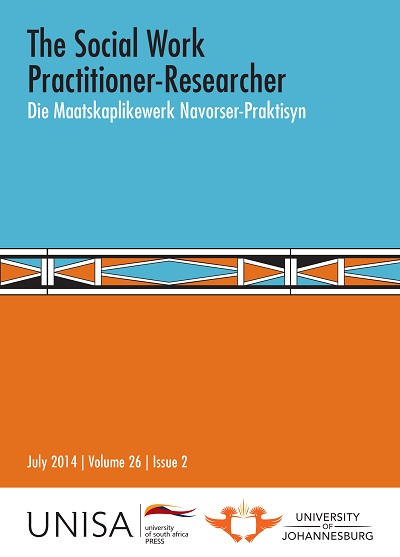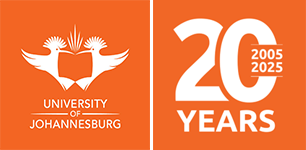Authors Guideline

The Social Work Practitioner-Researcher
Die Maatskaplikewerk Navorser-Praktisyn
Editor: Prof Jean Triegaardt, University of Johannesburg
Hosted by the Department of Social Work, University of Johannesburg
Published by Unisa Press
ISSN: 1011-2324
Author Guidelines
Editorial Scope
The Social Work Practitioner-Researcher is a refereed interdisciplinary journal for social workers and social service professionals concerned with the advancement of the theory and practice of social work and social development in Africa and in a changing global world. The purpose of the journal is to promote research and innovation in the practice of helping individuals, families, groups, organisations and communities to promote development and human well-being in society. The journal is committed to the creation of empowered, humane, just and democratic societies.
Manuscripts that would be appropriate are: 1) conceptual analyses and theoretical presentations; 2) literature reviews that provide new insights or new research questions; 3) manuscripts that report empirical work. Topics that will be considered include, but are not limited to, the following: lifespan, populations at risk, poverty, livelihoods, anti-discriminatory practice, welfare systems, development management, social security, social policy, human rights, community-based development, social development, comparative health, mental health, education, urban and rural development, voluntarism, civic service, civil society, social movements and social change.
As it is the intention of this journal to maintain a balance between theory and practice, contributors are encouraged to spell out the practical implications of their work for those involved in social work practice and the social services in the African context.
Ethical Protocol for Submissions
The editorial board assumes no responsibility for opinions expressed by contributors.
A decision to submit an article to this journal means that you will not be able to simultaneously submit the same article, or verbatim sections of the same/original article within another/second article, and then submit that to another journal in South Africa or elsewhere. We require a letter from you/all the authors stating this.
If there is more than one author, we require a letter stating that all the authors agree to submit the article. If a person has contributed to the research of the article and is not going to be included as a co-author, then that person needs to be acknowledged after the reference list.
The reviewing process
Manuscripts should be submitted as electronic attachments to the journal administrator, swjournal@uj.ac.za, in Word format. Authors should not be identified anywhere in the article.
The manuscript is sent to the Editor or Assistant Editor for approval. If it is judged suitable for this journal, it is sent to two reviewers for blind peer-review. Based on their recommendations, the editorial committee decides whether the manuscript should be accepted as is, revised or rejected. If the manuscript is published, the author or their institution will be invoiced for page fees at the rate of R130.00 per page.
Presentation
- A minimum length of 3 500 words and a maximum length of 6 000 words (excluding references). No footnotes, endnotes and annexures are allowed.
- On a separate page, a title of not more than ten words should be provided. The author’s full name and title, position, institutional affiliation and e-mail address should be supplied.
- An abstract of 150 words plus up to six keywords, which encapsulate the principal topics of the paper, must be included. The abstract should summarise the key argument/s of the article and locate the article in its theoretical practice and context. Please note that abstracts are not summaries of research studies. No sub-headings should be used in the abstract. For Afrikaans articles, the abstract and keywords must be in English.
- Headings must be short, clear and not numbered: main headings to be in bold capitals; first stage subheadings to be in bold lower case, with only the first letter of the first word to be a capital (not underlined, nor in italics); and second stage subheadings in normal type to follow the first stage style.
- Figures and tables:
All figures (diagrams and line drawings) should be copied and pasted or saved and imported from the origination software into a blank Microsoft Word document and submitted electronically. Figures should be of clear quality, black and white, and numbered consecutively with arabic numerals. Supply succinct and clear captions for all figures. The maximum portrait width should not exceed 110mm and 160mm depth. For landscape, the maximum width is 160mm with a maximum depth of 110mm.
In the text of the paper, the preferred position of all figures should be indicated by typing on a separate line the words, “Place figure (No.) here”.
Tables must be numbered consecutively with arabic numerals and a brief title should be provided. In the text, type on a separate line the words, “Place Table (No.) here” should show the position of the table.
- References:
In text, publications are to be cited using one of the following examples: (Adams, 1997), or (Mbatha et al., 2005), or Mercy et al. (2002). Use ‘and’, not the ‘&’ symbol, for two or more authors, eg. (Weyers and Herbst, 2014)
If a direct quote is used in text, references should include author’s name/s, date and page number, eg; …. “usually to improve the working relationship between members of the group” (Barker, 2003:153). Where there are no direct quotes, page numbers should not be included.
At the end of the paper, the reference list should be in alphabetical order. Do not use indentations when formatting your references.
References to publications must be in modified Harvard style and checked for completeness, accuracy and consistency. Include all authors’ names and initials and give the book’s, or book chapter’s, or journal’s title in full.
Please cross check that only references cited in the text are included in the final reference list at the end of the article (and vice versa). Use ‘and’, not the ‘&’ symbol, for two or more authors as mentioned above. References should follow the style as set out below:
For books:
Surname, Initials. (year). Title of Book Place of Publication: Publisher.
Example:
Swanepoel, H. and De Beer, F. (1996). Community Capacity Building Johannesburg: Thomson Publishing.
For book chapters:
Surname, Initials. (year). “Chapter Title” in Editor’s Surname, Initials. (Ed.). Title of Book Place of Publication: Publisher, Edition, pages.
Example:
A Reader in Selected Social Issues Pretoria: Van Schaik Publishers, Second Edition, 41-52.
For journals:
Surname, Initials. (year). “Title of Article” Journal Name Volume(number):pages
Example:
Mda, C.J. (2004). “Population Ageing and Survival Challenges in Rural Ghana” Journal of Social Development in Africa19(2):90-112.
For electronic sources:
If available online the full URL should be supplied at the end of the reference.
Example:
Louisiana State Board of Social Work Examiners. (1998). “Guidelines for Child Custody Evaluations”,http://www.labswe.org/child.htm (Accessed on 23/08/2006).
Content
Manuscripts should contribute to knowledge development in social work, social welfare or related professions and the practice implications of the research should be spelled out. Sufficient and appropriate recent literature should be cited. Where the study is based on empirical research, the research design and methodology, results, discussion and conclusion should be addressed. All manuscripts should locate the issue within its social context and the conceptual and theoretical framework informing the study should be clearly outlined.
The journal will consider articles based on research studies but we will not publish articles which are merely a summary of a research report. The article should have a clear focus that contributes to knowledge building or informs policy and/or practice.
